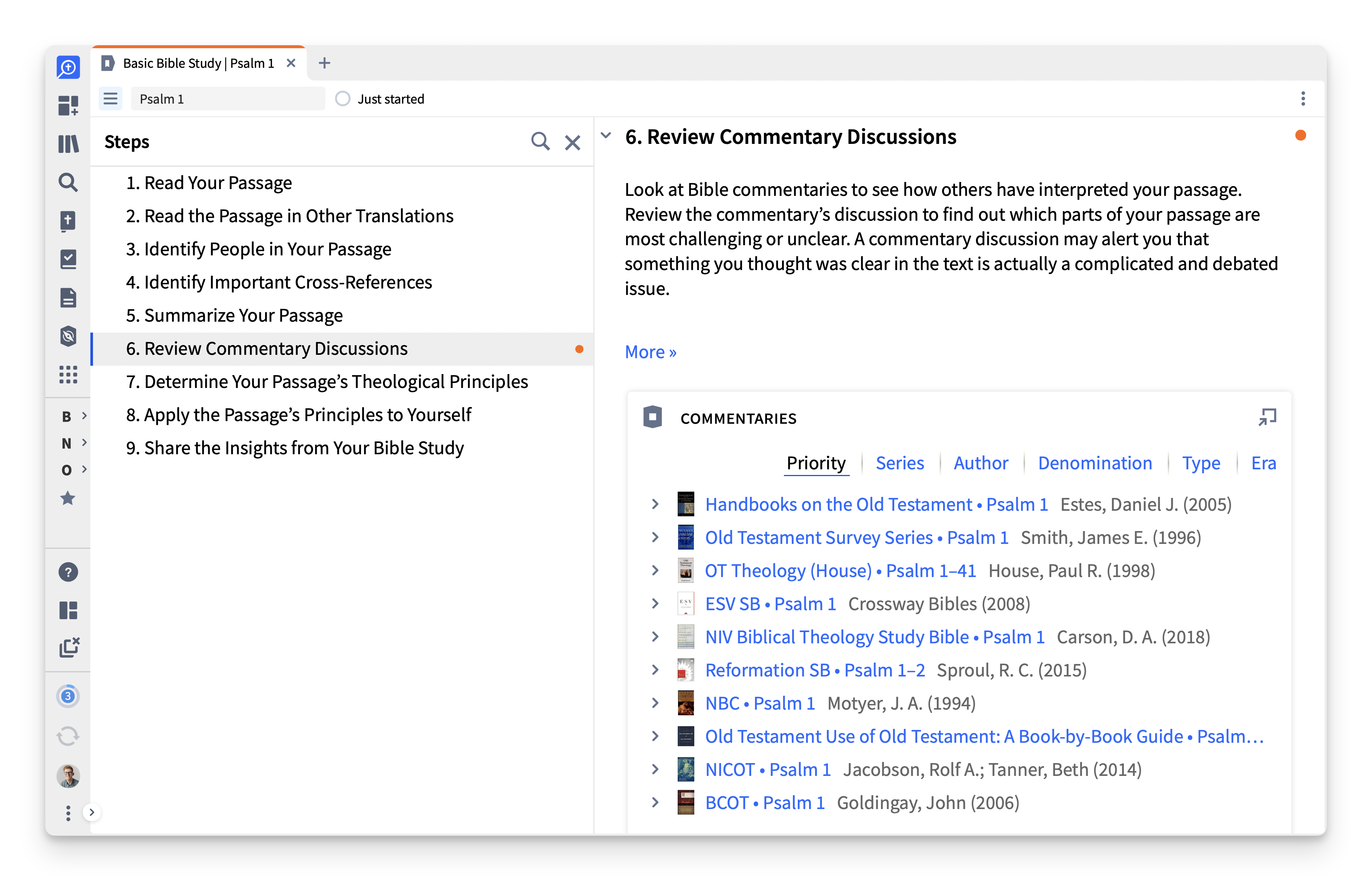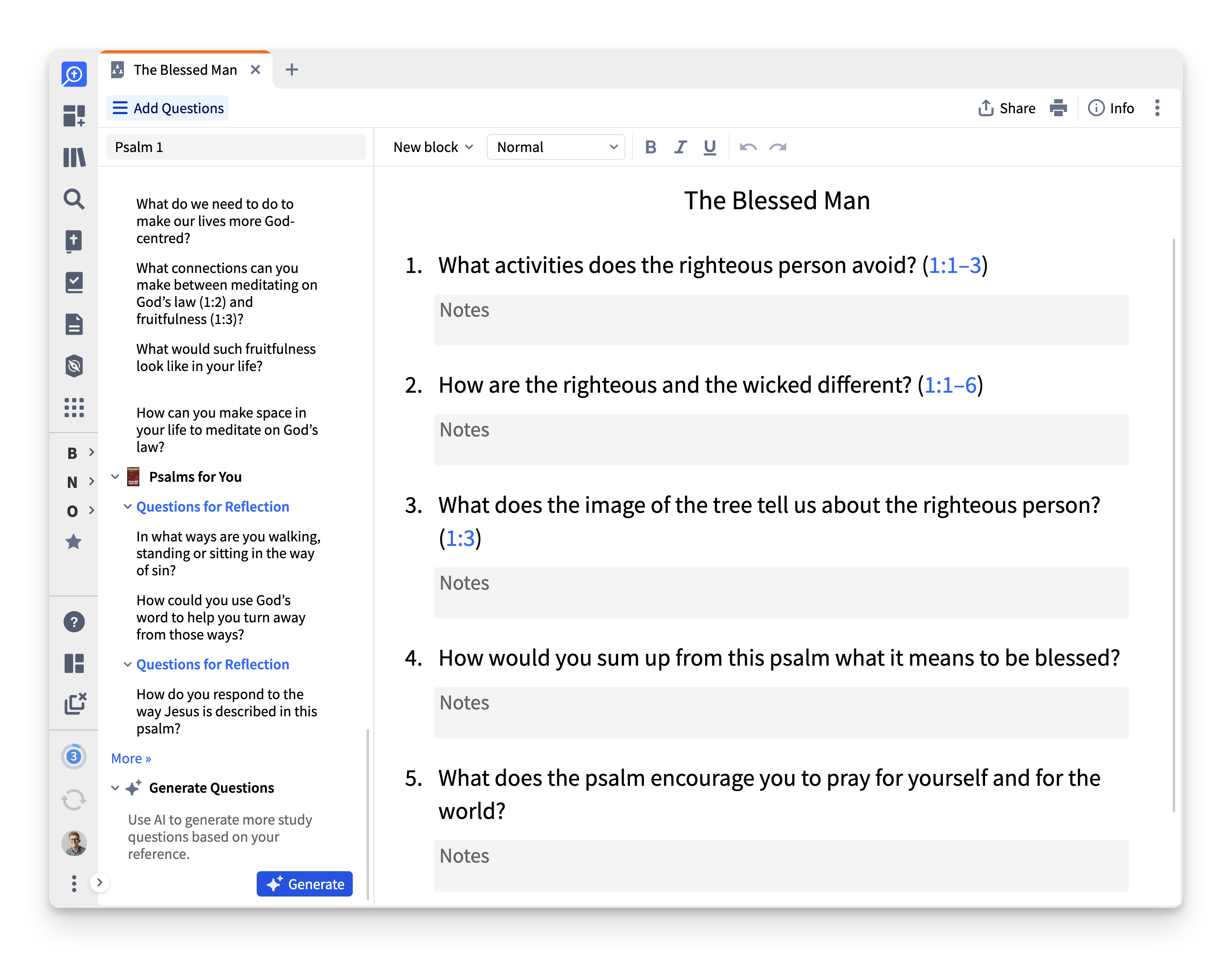It’s one thing to lead a Bible study; it’s another to lead a Bible study that people love! What’s the difference between a study that people endure and one they can’t wait to attend?
Effective Bible study leaders invite people to engage with the text of Scripture while giving enough guidance to keep discussions profitable and on task. They know their material well enough to lecture, yet they generously lead their groups to discover truth for themselves. They don’t pitch facts at people. Rather, they invite their groups into the adventure of the world’s greatest treasure hunt.
When a Bible study leader knows both the text and people enough to ask questions that help them discover truth, the stage is set for Bible study excellence and enjoyment. The stage is set for life change. What’s not to love?
But how do we get there? Well, the great news is that leading such Bible studies is a skill you can develop.
Table of Contents
1. Have the right mindset
Years ago, as a young Bible study leader, I would marvel at the seeming ease of those who had been leading for years. What I found difficult, they seemed to find effortless. These seasoned leaders demonstrated an ease with both the text and people, allowing their groups to relax and engage. In the moment it seemed like they had something that I simply lacked (and feared I might always lack!): a natural ability to discuss the text of Scripture and help other people see its truth.
Discovered truth, after all, satisfies far more deeply than spoon-fed truth, no matter how lovely the spoon.
Over time, though, I discovered that what appeared simple and natural to some was largely the result of proper preparation and practice in asking good questions to help people to uncover the truth for themselves. Discovered truth, after all, satisfies far more deeply than spoon-fed truth, no matter how lovely the spoon.
Dispense with the common fear
Unfortunately, many people miss out on leading others due to paralyzing fear. Fear of failure on some level knocks many potential Bible study leaders out before they even start.
Perhaps the most common fear is the prospect of not knowing enough: What if they ask a question I can’t answer? What if the group knows more than I do? Fair enough. The thought of having even moderate mastery of the whole text of Scripture is daunting. No matter how much you know or prepare, someone will inevitably ask a question you can’t answer or a group member will know more than you do somewhere along the way. Added to this, anyone with a computer today has access to more information—and questions!—than generations prior could have ever imagined.
But we don’t need to be overwhelmed. No one but God has all the answers! Remember that while the Bible weighs in at over three-quarters of a million words—talk about overwhelming!—the typical Bible study focuses on only a tiny portion.
Additionally, guided by the Holy Spirit and prayer, Logos offers tools to make it simple to achieve competence on any Bible passage (more on this below).
Be a guide, not a guru
One of the greatest temptations for newer Bible study leaders is trying to be the guru or answer person. There’s an emotional payoff in providing all the answers, but it does a disservice to everyone involved. Instead, an effective Bible study leader guides people in discussion to discover truth for themselves rather than telling them what they should see.
Bible study leaders should seek to model to others a posture of learning. When we see ourselves as lifelong learners, we demonstrate both humility and hope and build rapport with the group. Instead of “us” (the teachers) and “them” (the students), we display that we are all members of one another in the body of Christ. No one has arrived, no one is finished, and we are all continually learning and growing up together to maturity (see Eph 4:15–16; 1 Cor 12:12–26). We run the relay race of faith, where those who teach entrust the truth to the faithful who will be able to teach others also (2 Tim 2:2).
An effective Bible study leader guides people in discussion to discover truth for themselves rather than telling them what they should see.
Learn the hardest phrase: “I don’t know”
Harder to say than Mahershalalhashbaz (Isaiah 8:1) and Chedorlaomer (Genesis 14:1) is the phrase “I don’t know.” It is, though, a phrase that the wise Bible study leader will master.
No matter how much you study, no matter how smart you are, there will be questions that you will not have answers for. Sometimes you won’t know because the text doesn’t say. After all, we know from Deuteronomy 29:29 that “the secret things belong to the Lord” (ESV). But even of the things revealed, we will not always have an answer. Even the wisest among us will never master the entire Word of God.
Several things happen when we mouth the words “I don’t know.” First, we display humility. Admitting that we don’t know something, instead of dodging or guessing, shows our group humility. When we show humility, something else happens: We build rapport with others, and they are able to see us as fellow learners. We create an environment of transparency and trust that serves everyone.
2. Study the passage
While we come to the passage with humility, we also come with hope and expectation, doing our best to know the passage well by immersing ourselves in it prayerfully.
Prayerfully read the text
No amount of study tools or resources compare with time simply spent reading and meditating prayerfully on the text. To that end, I love the way that Logos puts so many versions of the text at my fingertips so I can easily consult multiple translations.

Use Logos’s Text Comparison to compare multiple versions of a text at once.

Or open multiple Bible translations and connect them to scroll in unison using Link Sets.
Mark up the text
As I read and meditate on God’s Word, I like to attach notes recording my observations and reflections. Marking the text helps me see key repeated words and concepts in the text.
Logos makes the process simple, particularly on the desktop version, using Highlights and Notes. I love the flexibility of being able to combine color, font size, and symbols to mark the text. Having the ability to choose the marking I want visible (using the dynamic Toolbar) is gold!

If I’m feeling more old school, I can also use Logos to print the text to mark up with pens and pencils. Or I like export PDFs of the text to up mark digitally with my Apple Pencil using Nebo, one of many available note-taking apps. Printing and exporting the text can also be a great resource to provide group members.

Dig in with the Passage Guide
After my initial time reading the text, I use the Logos Passage Guide to compile nearly everything else I need for my study. The Passage Guide pulls my commentaries together and alerts me to relevant cross-references, parallel passages, and important words in the text that I may have overlooked. It also locates any of my own content that I’ve recorded in Logos on the queried passage.
While I only use a portion of what’s available, the Passage Guide can compile information on over 45 categories related to any given passage. I can customize what to include by simply adding or removing categories as needed so I’m not overwhelmed by what I don’t want to see. In an age of information overload, I always love a “show less” option!

Think of the Passage Guide as the treasure box of information for those who already know their Bible study path.
Clear study paths: Workflows
For those newer to study and leading studies, Logos Workflows provide prompts to walk users through the study process, linking to the needed tools along the way. Think of workflows as your turn-by-turn navigator.
While there are many workflows to choose from, two in particular lay a simple but robust foundation for everyday Bible study. The Inductive Bible Study Workflow and Basic Bible Study Workflow will prompt you through a study process built around observing, interpreting, and applying Scripture.
As you progress through the steps and enter your responses, Logos tracks your progress, records your work as notes, and links to tools within Logos that will be helpful at different steps. If the workflow prompts you to consult a commentary, it will populate with your books. If it prompts you to research cross-references, you will find links to those right there in the workflow. You do the study, but workflows clear the path and make sure the proper tools are at the ready.

New tools I’m loving: Smart Search and Synopsis
From time to time as I study, I run across a question that stumps me to the point that I’m not even sure where to turn. It’s easy to lose substantial time scouring through commentaries and references looking for help.
Logos’s new Smart Search coupled with Smart Search Synopsis allows me to use natural language to search the whole Logos universe and receive an answer to my question in summary form. It even provides appropriate citations so I’m not stuck trusting a bot; I can check the sources for myself.

If you’re leery of AI, I understand. I’m sickened that so much online writing these days is nothing more than bots creating clickbait.
So I wanted to hate these new features. But, as it turns out, I love them! The new features are impressive additions that I’m finding myself using more and more to quickly locate stealthy resources. If AI must be among us, let’s at least optimize its power for good.
3. Prepare your lesson
Leading an effective Bible study starts with the leader studying to become conversant with the text, but it does not end there. The rest of the job is guiding others to the text so that they can come to see it for themselves.
Facilitate self-discovery through questions
People love Bible studies where they see the truth with their own eyes, when they discover truth instead of simply being told what to see. The effective leader will help facilitate that process of discovery.
This happens most effectively when a leader engages the group with questions that help members engage in discussion and see Scripture for themselves. Through the use of questions, the leader can help the group reason through the text to discover its meaning and then apply it to their lives.
Bible studies that move the needle of life-change never stop with information only. They always help people apply Scripture to their own lives. They guide people from the original meaning of the text in its historical context to the varied ways the text calls for obedience in our lives today. Transformation, it turns out, results not from merely knowing truth propositionally, but applying it personally.
Transformation, it turns out, results not from merely knowing truth propositionally, but applying it personally.
A discussion-based class has the feel of playing a game of catch: You always have to be alert in case the ball comes your direction. No one is a mere observer; everyone is in the game. While a discussion involves dynamic elements—you never know how the people in the group will respond—having questions prepared in advance provides the scaffolding needed to help keep the group on track and prevent discussion drift.
The new Bible Study Builder in Logos is the tool for the job.
Your Bible Study Builder: elegant simplicity
The new Bible Study Builder provides an elegantly simple framework that allows you to write your own Bible study questions, draw questions from books in your library, or ask AI to offer suggestions.
As you select your questions, give attention to the journalistic five Ws and one H:
- Who
- What
- When
- Where
- Why
- How
These help your group discover what the text says, what it means, and how to apply it.

You can also add notes under each question on the Bible Study Builder—and hide them from a final printout. When finished with your lesson, print it either as handouts for the group or as a teaching guide for yourself.
4. Guide the group
You’ve studied the text; you’ve prepared your questions. Now that the time has come, it’s important to lay some ground rules with your group and have your tools ready.
Set parameters early
Effective Bible study leaders set parameters early and clearly. This helps the group to know what to expect and keep discussions on track.
Stick to the text
When everyone knows up front that the group will be focused on the text, no one should be offended if the leader gently redirects off-topic discussion back to Scripture. If a discussion starts heading far afield, simply asking, “Where do you see that in the text?” can typically recalibrate and reorient the group.
The leader is not the “answer person”
If everyone knows up front that the Bible study leader is not the “answer person,” it can reduce the number of off-topic, difficult questions that can take a discussion sideways. When an off-topic question does arise, as they will on occasion, be ready with, “That’s a great question. Why don’t you look into that this week and report back?” This response encourages people with genuine questions while discouraging people who just like to stir the pot.
No one will be called out
An overriding goal will be to help everyone feel safe and comfortable sharing. I’ve found that assuring people I won’t ever put them on the spot helps everyone breathe easier. My classes know they never need to avert their eyes to keep me from calling on them. I only call on people who indicate they want to talk. I think of it as shepherding the sheep as opposed to driving the cattle. No one wants to attend an adult Bible study only to feel like a high school sophomore called up to the board to write out a proof.
Listen and provide encouragement
When people do answer or comment, listen well and give encouragement on the comment whenever possible. Ask follow up questions to guide the discussion forward as appropriate.
Guide with questions and gentleness
Discussions are dynamic by definition, so there’s only so much preparation a leader can do in advance to plan how things will go. People will occasionally ask difficult questions or jump the rails with comments unrelated to the topic. These game-day challenges can cause angst, particularly in newer leaders.
The temptation for many will be to jump in as the orthodoxy police and set things straight. This often feels good in the moment as you puff up and earnestly contend for the faith, but know that this approach will dampen discussion, especially from those in the room who are more timid. A better approach is to draw redirect the discussion back on topic through questions and guide people gently to the truth.
With electronic devices, Bible study leaders today have additional teaching aids.
First, using Logos for my Bible and teaching notes allows me to navigate between passages and other content, like my teaching notes, on the fly.

Second, I love the ability to share my screen through external monitors or on Zoom so my group can see exactly what I’m referring to in the text. It is a great way to keep an increasingly visual population engaged. The options are endless with a little creativity!
The bottom line
People love Bible studies that help them see for themselves what God says in his Word. Effective Bible study leaders don’t tell people what to see in the text. They use questions and discussion to invite others to discover the power of God’s Word for themselves.

 1 month ago
23
1 month ago
23










 English (US) ·
English (US) ·